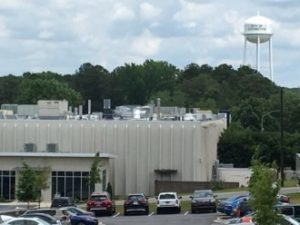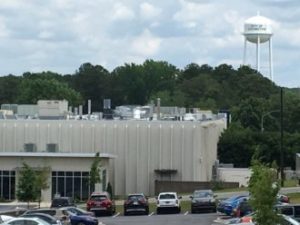Brenda Goodman is a senior news writer for WebMD. Andy Miller is editor and CEO of Georgia Health News.
Local residents and their elected officials in metro Atlanta are responding with concern after learning that a cancer-causing gas could be drifting through the air near their homes, schools and workplaces.
On Friday, WebMD and Georgia Health News revealed that Georgia had three census tracts the EPA identified as having elevated cancer risks because of a toxic gas called ethylene oxide. All are in metro Atlanta: Two in the Smyrna area northwest of the city; one is in Covington, east of Atlanta.
In Smyrna, the plant that releases ethylene oxide is run by Sterigenics. In Covington, the plant is known as BD Bard. Nationally, 109 census tracts are at risk for greater numbers of cancers largely due to ethylene oxide, a chemical used to sterilize medical equipment and make other kinds of products like antifreeze.
On various social media platforms, residents and public officials shared their concerns and questions. Many of their comments centered around the fact that the EPA did little to publicize their findings on the cancer dangers.
Local governments in Smyrna and Covington posted statements to their websites to reassure citizens that although they were also learning about the problem for the first time, they were starting to work on it.
“I am incredibly shocked, terrified and enraged to learn about this plant,” said one woman who posted to the public Stop Sterigenics Facebook page. Stop Sterigenics is a group of citizens from Willowbrook, IL, which is home to a separate Sterigenics location. They organized last August after learning of the ethylene oxide pollution and higher cancer risk in their own community.

Stop Sterigenics posted a new welcome message on Monday for Atlanta-area members who were just joining.
“So many questions,” said one man who posted on the Facebook page for the Newton Citizen, the local newspaper in Covington, which posted the story as a media partner of Georgia Health News. “So the EPA produces a list of 109 census tracts where airborne toxins have elevated the cancer risk (useful!) but then does… nothing with it?” Not useful!” he wrote, “What else don’t we know?”
In the Smyrna area, citizens were preparing a public meeting for 7:30 p.m. Wednesday at the Atlanta Freethought Society on North Church Lane.
Tony Adams, a Smyrna area resident who is helping to organize the meeting, called the response from the community “overwhelming” on the neighborhood’s NextDoor online group.
“We want to know that if there’s a human carcinogen being emitted, how much of it is being emitted? And what are the long-term effects?” Adams said.
“We want to be involved, and we want to know the next step. We need to be organized,” he said.
Karen Hays, air branch chief for the Georgia Environmental Protection Division, responded to the article in the Marietta Daily Journal, which posted the story as a media partner of Georgia Health News.
“I think the story was trying to make people concerned, not trying to give the whole picture,” Hays said.

In Covington, city council members discussed the revelations about the ethylene oxide pollution Monday night in a regularly scheduled meeting.
Council Member Anthony Henderson took issue with EPD’s position. “I just think that unfortunately the EPD thinks that the numbers are not really resulting in affecting people or really trying to get the people’s side of the view of it,” he said. “One life is too many or too much to sacrifice in a situation like that. Myself, the City Council and the city will do everything that we can do to see that the situation is resolved,” he said, according to the Newton Citizen.
Georgia State Sen. Jen Jordan, a Democrat who represents the Smyrna area, said she had spoken to Phillip MacNabb, the president of Sterigenics, on Tuesday. He said the company would be submitting an application to Georgia EPD within two weeks to install new pollution control technology at its Cobb County plant. EPD would have to approve the application.

The city of Smyrna posted a brief statement on its website Monday to let local residents know that although the Sterigenics plant sits outside of its official jurisdiction, “We are now aware and part of a larger set of local and state voices working to address this alarming news and circumstance.”
The city of Covington also issued a brief statement, saying that although it had just learned about the health concerns from ethylene oxide in the community, city officials were working on it.
“Know that the safety of our citizens is our highest priority. We have briefly spoken with our state representatives, officials from the EPA and BD and are awaiting further detail from them. As more information is gathered, the city will take appropriate action as necessary to protect our citizens.”
Sources:
Tony Adams, Resident, Cobb County, GA
City of Smyrna, Statement, July 22, 2019
Jen Jordan, Georgia State Senator, District 6, Smyrna, GA
Anthony Henderson, City Council Member, Covington, GA
Karen Hays, Air Branch Chief, Georgia Department of Natural Resources, Environmental Protection Division, Atlanta, GA
“Local Lawmakers React to Report of Cancer-Causing Emissions Near Smyrna,” Marietta Daily Journal, July 23, 2019
WebMD and Georgia Health News, “Residents Unaware of Cancer-Causing Toxin in Air,” July 19, 2019
“The Safety of Our Citizens Is Our Highest Priority, Says Covington Mayor,’’ Newton Citizen, July 23, 2019

